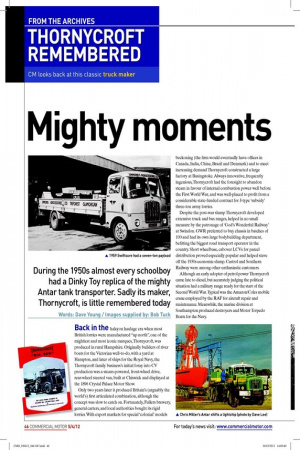Mighty moments
Page 38

Page 39

If you've noticed an error in this article please click here to report it so we can fix it.
FROM THE ARCHIVES
THORNYCROFT REMEMBERED
CM looks back at this classic truck maker
During the 1950s almost every schoolboy had a Dinky Toy replica of the mighty Antar tank transporter. Sadly its maker, Thornycroft, is little remembered today
Words: Dave Young / Images supplied by: Bob Tuck Back in the halcyon haulage era when most British lorries were manufactured “up north” , one of the mightiest and most iconic marques, Thornycroft, was produced in rural Hampshire. Originally builders of river boats for the Victorian well-to-do, with a yard at Hampton, and later of ships for the Royal Navy, the Thornycroft family business’s initial foray into CV production was a steam-powered, front-wheel drive, rear-wheel steered van, built at Chiswick and displayed at the 1896 Crystal Palace Motor Show.
Only two years later it produced Britain’s (arguably the world’s) irst articulated combination, although the concept was slow to catch on. Fortunately, Fullers brewery, general carters, and local authorities bought its rigid lorries. With export markets for special ‘colonial’ models beckoning (the irm would eventually have ofices in Canada, India, China, Brazil and Denmark) and to meet increasing demand Thornycroft constructed a large factory at Basingstoke. Always innovative, frequently ingenious, Thornycroft had the foresight to abandon steam in favour of internal combustion power well before the First World War, and was well-placed to proit from a considerable state-funded contract for J-type ‘subsidy’ three-ton army lorries.
Despite the post-war slump Thornycroft developed extensive truck and bus ranges, helped in no small measure by the patronage of ‘God’s Wonderful Railway’ at Swindon. GWR preferred to buy chassis in batches of 100 and had its own large bodybuilding department, beitting the biggest road transport operator in the country. Short wheelbase, cabover LCVs for parcel distribution proved especially popular and helped stave off the 1930s economic slump. Castrol and Southern Railway were among other enthusiastic customers.
Although an early adopter of petrol power Thornycroft came late to diesel, but accurately judging the political situation had a military range ready for the start of the Second World War. Typical was the Amazon/Coles mobile crane employed by the RAF for aircraft repair and maintenance. Meanwhile, the marine division at Southampton produced destroyers and Motor Torpedo Boats for the Navy. Post-war truck models such as the Trusty and Sturdy entered production for the home market, while the rugged, bonneted Big Ben was aimed at overseas buyers. Most iconic of all, and Thornycroft’s legacy to CV history, was the iconic Mighty Antar. Traditionally a standalone manufacturer, in later years Thornycroft itted a higher proportion of proprietary parts – including engines by Gardner and even Mercedes-Benz. The use of Motor Panel cabs led to some exterior confusion with Guy models and while the Trusty eight-wheeler chassis proved popular with BRS, by the 1960s Thornycroft were offering an expensive and overly complex model range to a declining market. Despite a reputation for excellent quality products, the large factory was underutilised and attempts at diversiication – such as a prototype 4x4 chassis for Ford with a Thames Trader cab – faltered when US engineers baulked at Thornycroft’s amateurish cost control.
Bought by AEC, in turn taken over by British Leyland, which already owned Scammell just up the road in Watford, Thornycroft was left with little but specialist multidrive off-road sales – such as the ubiquitous Nubian airport ire tender. The Basingstoke HQ (now demolished) was sold to Eaton in 1969 and the last complete truck (humiliatingly a badge-engineered Aveling Barford dumper) was assembled in 1977. Most of Thornycroft (and Scammell’s) design rights passed to Unipower. ■
THE MIGHTY ANTAR
Thornycroft’s heavyweight: a forces’ favourite
In 1950 the Iraq Petroleum Co bought a batch of purpose-built, 100-ton GTW Antars to work on the construction of a 560-mile cross-desert pipeline from Kirkuk to Banias, in temperatures ranging from 20°F to 120°F.
The first models, claimed in contemporary publicity material to be Britain’s biggest tractors and the most powerful trucks of their time, were designed to haul 60-ton loads of 93ft long steel pipes, powered by an 18-litre V8 Rover Meteorite petrol engine (derived from the Rolls-Royce V12 Merlin in the Spitfire) with an aluminium crankcase, cylinder block and heads, producing 285hp at 2,000rpm and cooled by twin radiators. This was a tad thirsty even for an oil company and it was later replaced by a Rolls-Royce 16-litre 330hp diesel.
Massive in the proper sense of the word, an amazing total of 730 over-engineered 6x4 Antars were eventually produced and several went on to work for heavy haulage specialists such as Chris Milller and Jack Hill.
In 1951, the first Antars entered British Army service. These were fixed-body steel-built ballast tractors pulling 50-ton Dyson trailers, employed to carry the then new Centurion tanks. A semi-trailer version of the Antar (the one immortalised by Dinky) followed, replacing the Second World War vintage American Diamond T as the British Army’s main battle tank transporter. Antars remained in service until the mid-1980s, and were eventually superseded by the Scammell Commander.
Antar on trade plates at the North Circular Road Edmonton Regal junction in 1950
Vital stats:
Length: 26ft (7.9m) ● Width: 10ft 3in (3.1m) ● Height: 10ft (3m) ULW: 43,240lb (19,610kg) ● Transmission: Four-speed full “crash gearbox” with three-speed transfer casing and power takeoff. Two live worm-drive rear axles with inboard epicyclic reduction ● Speed: 28mph (45km/h) on level ground. Later versions 35mph (56km/h) ● GTW: Typically 101 tons; (road-tested at 126 tons).
FIND OUT MORE
The definitive written history: ‘Thornycroft’, by Alan Townsin, Ian Allan Transport Library.
The excellent Hampshire County Council Milestones Museum is located a few hundred yards from the factory site in Basingstoke and houses a collection of Thornycroft vehicles and other exhibits, many transport related. www3.hants.gov.uk/thornycroft www3.hants.gov.uk/milestones www.the-antar.co.uk/ – great pictures of Antars in distress www.thornycroft.org.uk/ – a register of survivors











































